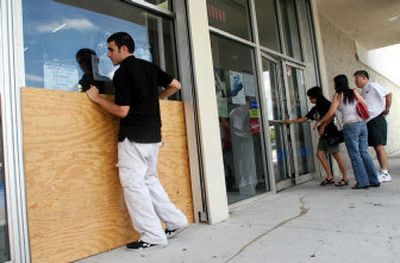Residents leave Keys as Rita grows

KEY WEST, Fla. – Residents boarded up windows Monday and evacuated the low-lying Florida Keys as Tropical Storm Rita gathered strength in the Bahamas, threatening to grow into a hurricane with a potential 8-foot storm surge.
In New Orleans, the mayor suspended his plan to start bringing residents back to the city Monday after forecasters warned that Rita could charge through the Gulf of Mexico and impact the city’s already weakened levees.
Oil prices surged on the possibility that oil and gas production would be interrupted again.
The storm’s top sustained wind speed was 70 mph by midafternoon Monday, and it was expected to strengthen into a Category 1 hurricane, with winds of at least 74 mph, by the time it approached the Keys early today.
“The main concern now is the Florida Keys,” said Max Mayfield, director of the National Hurricane Center in Miami. “It’s moving over very warm water, and that’s extremely favorable for development.”
Hurricane warnings were posted for the Keys and Miami-Dade County, the hurricane center said. Residents and visitors were ordered to clear out of the entire chain of islands, connected by just one highway. Voluntary evacuation orders were posted for some 134,000 Miami-Dade residents of coastal areas such as Miami Beach.
“This storm has some potential to it. The time to go is now,” said state emergency management director Craig Fugate.
While many Keys residents take pride in staying put during hurricanes, others said they were worried because of Katrina’s devastation of Louisiana and Mississippi. Most stores on Key West’s Duval Street were boarded up Monday and that and other streets were nearly empty as the sky turned cloudy.
“We’re going north, wherever the storm isn’t going,” John Williams said after he and Lisa Sparks got married Monday morning on the beach in Key West. They joked that if they had a baby girl they would name her Rita.
Rita is the 17th named storm of the Atlantic hurricane season, making this the fourth busiest season since record-keeping started in 1851. The record is 21 tropical storms in 1933. Six hurricanes have hit Florida in the past 13 months.
The National Weather Service warned that Rita could be worse for Key West than 1998’s Georges, the last hurricane to directly hit the island city. Georges, with 105-mph winds, damaged hundreds of homes and closed the city to tourists for two weeks.
Gov. Jeb Bush said Monday the highway patrol reported that traffic out of the Keys was moving well on U.S. 1. However, lines were forming at gas stations.
In the Bahamas, some public schools were closed as the storm worked its way up the islands with wind and rain.
Six to 15 inches of rain was possible in the Keys, with 3 to 5 inches possible across southern Florida. A storm surge rising 6 to 9 feet above normal tide level was predicted for the Keys.
Long-range forecasts can be off by hundreds of miles, but hurricane center forecasters warned people along the Gulf to watch Rita closely; officials in Galveston, Texas – nearly 900 miles from Key West – were already calling for a voluntary evacuation there. Forecasters said Rita could be near Mexico or Texas by the weekend, with a possibility that it could turn toward Louisiana.
“This is something everyone should be paying attention to,” said Daniel Brown, a hurricane center meteorologist. Katrina crossed South Florida into the Gulf last month before hitting Louisiana and Mississippi.
The man in charge of removing water from New Orleans and repairing levees warned that Rita could affect efforts to drain water out of the city.
“We’re watching Tropical Storm Rita’s projected path and, depending on its strength and how much rain falls, everything could change. Residents moving into the area may have to evacuate again,” Col. Duane Gapinski, commander of the Army Corps of Engineers Task Force Unwatering, said in a statement.
At 5 p.m., Rita was centered about 135 miles south-southeast of Nassau, Bahamas, and about 345 miles east-southeast of Key West. It was moving west-northwest near 14 mph, according to the hurricane center.
Elsewhere in the Atlantic, Hurricane Philippe was far out at sea and posed no immediate threat to land.
The hurricane season started June 1 and ends Nov. 30.